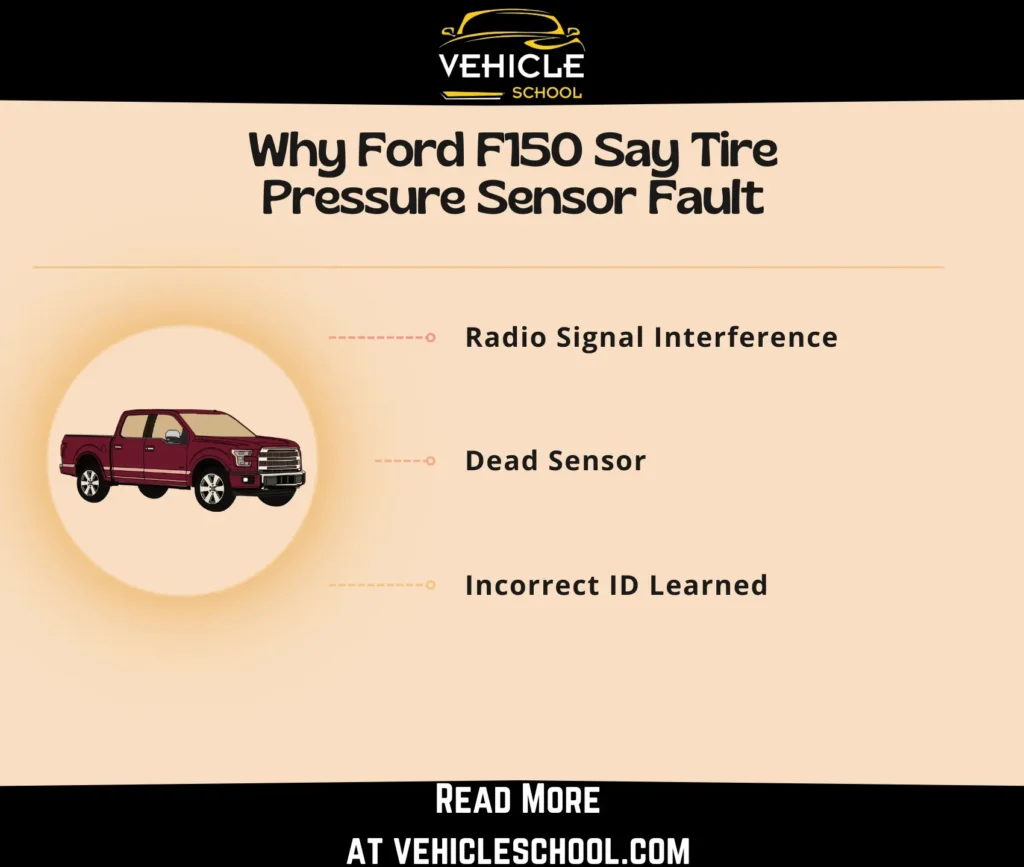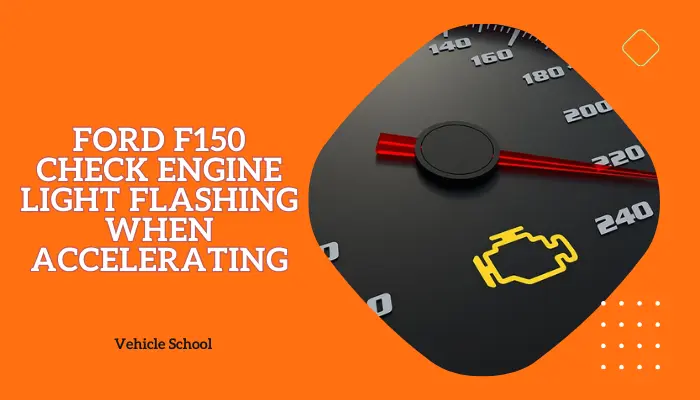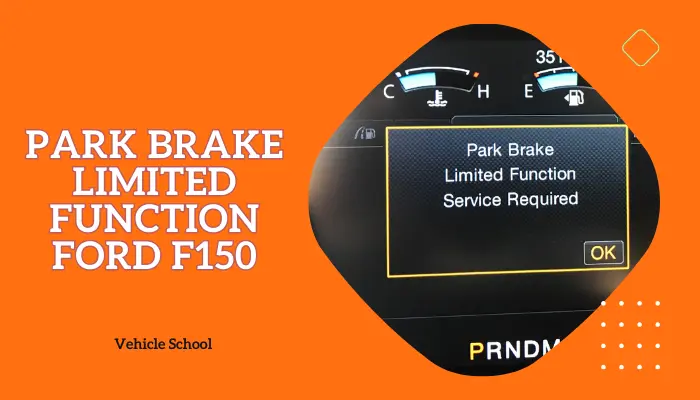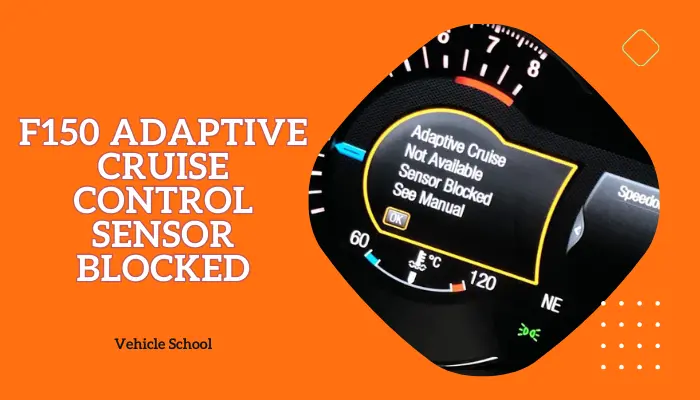If you are facing F150 tire pressure sensor fault, it’s because the battery’s dead, or the truck’s computer has the wrong ID for the sensor. USB chargers can also mess with your tire pressure sensors because of Radio Frequency Interference (RFI). To fix it, you’ll need to replace the sensor or reset the system.
Not sure how the replacement works or how to reset it? Check out the rest of this guide for more details.
Why Does Your Ford F150 Say Tire Pressure Sensor Fault?
Let me walk you through all the reasons you have to deal with such an issue first.

1. Radio Signal Interference
A specific USB charger connected may interfere with your Tire Pressure Sensor due to radio signals emitted by such devices.
When these signals interfere with the TPMS sensor signals, your truck displays the tire pressure sensor fault warning.
2. Dead Sensor
Tire pressure monitoring systems rely on sensors in your tires, which have batteries and switches inside to send data about tire pressure and temperature to your truck’s computer.
These sensors’ batteries can wear out or stop working, causing communication problems with the TPMS module.
If a sensor’s battery deteriorates or fails, it cannot send data when your truck moves, leading the TPMS module to think there’s a problem and show a tire pressure sensor fault warning on your dashboard.
3. Incorrect ID Learned
Sometimes, a tire pressure sensor fault happens because your truck’s TPMS module has the wrong ID for a sensor.
Each sensor has its own unique ID, so the TPMS module knows which tire is which. But if the ID in the module doesn’t match the one on the sensor, it can cause confusion and trigger a fault warning.
This mix-up can happen when you change sensors or swap wheels between different cars without updating the TPMS module.
How To Get Rid of Tire Pressure Sensor Fault In Your F150?
You’ll need to change the tire pressure sensor itself. Switching out the batteries is not an option since they’re stuck in resin. Follow these steps to replace the sensor:
- Get the truck ready to train the sensors by turning it off, then back on, and pressing the hazard button six times.
- Figure out which tire is acting up by following the prompts on the dashboard.
- Let some air out of the tire and listen for a beep from the horn.
- Repeat the process for the other tires.
- If it doesn’t beep when you try the above process, that’s the sensor you need to swap.
- Jack up the truck and take off the tire with the bad sensor.
- Use tools to take out the old sensor from the valve stem inside the tire.
- Put the new sensor in the same spot.
- Fill up the tire with air to the right pressure.
- Use a compressor to make sure the tire’s sitting right on the rim.
- Tighten up the tire back on the truck with the lug nuts.
- Make sure the TPMS warning light is gone by turning the car off and on again.
- Double-check everything, including tire pressure, and make sure that all the parts are in place and working.
Here’s a video demonstration of the process:
ford tire pressure sensor fault reset
Once you do a replacement, you’ll have to retrain the TPMS sensor. You can also give this a try first, the Incorrect ID issue is still common, and it might be that if you hear beeps with all the tires.
Resetting your Tire Pressure Monitoring System (TPMS) can be done manually with basic tools or by driving your truck for about 15-20 miles. If you’d rather do it yourself, you can buy a TPMS reset tool for around $14.
Before you begin, make sure each tire’s pressure matches what’s recommended for your vehicle. You can find this info on a sticker inside the driver’s side door or in the owner’s manual. Inflate or deflate the tires as needed.
Here’s how to reset your TPMS.
1. Using the TPMS Reset Button
- Turn on the truck without starting it.
- Find the TPMS reset button, usually near the steering wheel, and hold it until the dashboard light blinks three times.
- Let go of the button, start the ignition, and the light should turn off.
2. Inflate and Deflate Method
- Inflate all tires, including the spare, to 3 PSI over the recommended amount.
- Deflate all tires completely.
- Inflate all tires again to the recommended pressure to reset the TPMS sensors.
3. By Disconnecting The Battery
- With the truck off, open the hood.
- Disconnect the positive battery cable with a wrench.
- Turn on the truck, honk the horn for about three seconds, then reconnect the battery.
- This should reset the TPMS light by clearing out any stored power in the vehicle.
4. Ford’s suggested method for resetting TPMS:
- Drive above 20 mph for 2 minutes.
- Park safely with access to all tires and an air pump.
- Turn off ignition, but leave the key in.
- Turn ignition on without starting the engine.
- Flash hazard lights 3 times within 10 seconds.
- Train sensors starting from the left front tire, going clockwise.
- Release air from each tire until horn honks.
- Turn off the ignition after the last honk.
- Check for two short horn beeps; if heard, repeat the steps.
- Inflate tires to the recommended pressure.
You can find a more detailed version of these steps along with other relevant TPMS info on the Ford Service Content site.
| Tip: These sensors aren’t a must for safety. You can simply clear the message and do the sensor replacement during your next oil change. To get rid of the alert, just hold down the odometer reset button. Although, even after clearing the message, the little tire icon might still be lit up. |
FAQs
How much will it cost to replace the tire pressure sensor in your F-150?
Since you’ll be DIY-ing it, you won’t need to pay for labor. Without that, you’ll be paying around $45-$60.
Is it safe to drive the truck while it’s displaying the tire pressure sensor fault warning?
Yes, it’s generally fine to drive with an alert. It’s not a big deal because it’s just to give you pressure warnings.
Final Thoughts
As you see, there’s no worry of crashing due to the alert.
However, you should still err on the side of caution. It’s best to not let any alert linger too long, whether major or minor.
Fixing it will save you the hassle of manual checks as well, making things a tad bit more convenient.
So, whenever you get some spare time, give your tires a look.






